Last Updated on November 3, 2020
You’ll find plenty to entertain and occupy you during a visit to Mexico City. The obvious tourist spots are a great place to start and get your bearings before really digging in and seeing a different side of this fascinating capital city. After seeing the big boys it’s time escape the touristy hustle and join the local bustle. So this guide to free, non-touristy things to do in Mexico City shines a light on the path less taken.
In this guide are Diego Rivera masterpieces hidden in plain sight, an overlooked architectural marvel, a skinny lady with a questionable reputation and a weekly counterculture market for all things punk, metal, goth and indie. Of course, there’s more to recommend than these so read on. The amount of both touristy and non-touristy things to do in Mexico City during your visit will keep you busy for several weeks.
Non-Touristy Things to Do in Mexico City
This city is truly massive, so don’t expect to have these off the beaten path places to yourself. Instead, expect a great variety of markets, parks, historical places, museums and cultural wonders popular with locals and still full of great appeal to foreign visitors.
Getting to many of these sights requires time. So where applicable, this article suggests when to combine sights to save time. In addition, you’ll find helpful directions to each sight using public transportation. So get inspired and see more of Mexico City during your visit.
Whether visiting as a backpacker or a luxury traveller, these suggestions are crucial to your visit. Forget the same old suggestions and actually experience the wonder of true, independent exploration. Take our advice, then find your own path to follow along the way.
Where to Stay While Enjoying These Non-Touristy Things to Do in Mexico City
Take your accommodation options to the next level and look at these Airbnb stays in Mexico City. Discover an amazing assortment of rooms and apartments for rent while visiting this fascinating city! Make your stay comfortable and check out Airbnb.
Discover an impressive selection of rooms in Mexico City at Hotels.com right now. We recommend Hotels.com for the best deals and selection in Mexico City and throughout all of Mexico.
Disclosure: This article contains affiliate links to products and services whereby we receive a nominal commission if you make a purchase through one of these links. This comes at no extra cost to you. Please see our Disclaimer for full information.
Tianguis Cultural Del Chopo
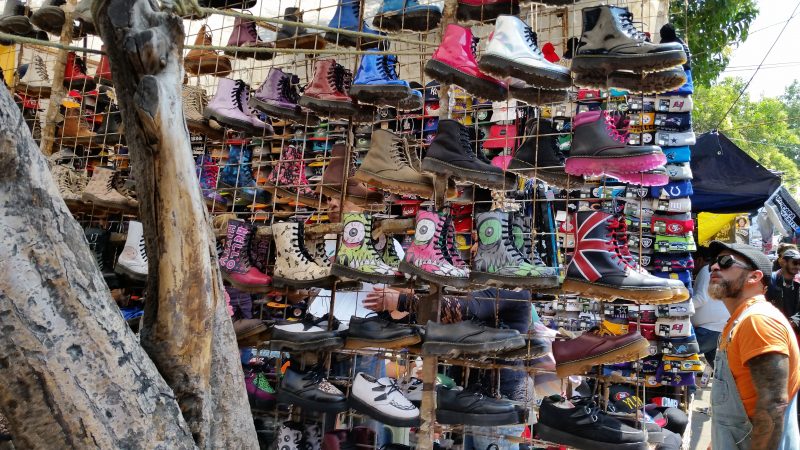
Where: This alternative Mexico City flea market is on Calle Juan Aldama at the east side of Vasconcelos Library. From Buenavisita Metro Station (Line B) follow the hordes of metal, punk, goth, emo and social angst folk making their collective way to this weekly gathering place.
When: 10:00 am – 4:00 pm every Saturday.
Combine: Tianguis Cultural Del Chopo easily combines with another of our non-touristy things to do in Mexico City – Vasconcelos Library (below).
Mexico City’s dark denizens emerge from the shadows every Saturday at Tianguis Cultural Del Chopo. Stalls selling CDs, t-shirts, Doc boots, records, patches, decals and a general mish-mash of sub-culture merchandise populate a length of this inner-city street. Folks gather to sell and swap while celebrating all things heavy metal and punk. The atmosphere here is certainly reminiscent of a music festival.
An amazing stage with a power station as a backdrop is where the magic really happens. By early afternoon young bands perform on-stage under the buzzing and crackling of electrical wires. If you’re really looking for non-touristy things to do in Mexico City, this is certainly the place. So visit this counterculture cornucopia and have a wicked good time.
Biblioteca Vasconcelos

Where: Opposite Buenavista Metro Station (Line B) on Eje. 1 Norte.
Hours: 8:30 am – 7:30 pm daily.
For a dose of modern architecture pop into this amazing Mexico City library. The architectural ingenuity and design certainly makes you question your sense of perception. Levels of shelves are suspended in mid-air, baffling your sense of space and distance. The photo above hopefully expresses the incredible sensory illusion at play. The hanging whale skeleton works rather well, especially after visiting Tianguis Cultural Del Chopo.
Tianguis de Antigüedades or Mercado de Cuauhtémoc

Where: This little-known Mexico City flea market is at the corners of Avenida Cuauhtémoc and Dr. Navarro. Vendors set up on the sidewalks lining Jardín Dr. Ignacio Chávez. Take the Metro to Cuauhtémoc Metro Station (Line 1); Jardín Dr. Ignacio Chávez is 2 blocks south.
When: 9:00 am – 4:00 pm every Saturday and Sunday.
Combine: Visit Chapultepec Zoo (below) along with this interesting local market.
This nirvana of vintage cast-offs, also known as Bazar de Cuauhtémoc, takes place on the outskirts of a small neighbourhood park called Jardín Dr. Chávez in the Colonia Doctores neighbourhood. Antiques, kitsch, retro, bric-a-brac, and enough ephemera goods to ironically decorate the most discerning hipster’s hovel are found here.
Vendors especially focus on old action figures and toys, military memorabilia, cool furnishings and old fashioned advertisements. As a result you’re guaranteed to spot something familiar or fresh among the classic collectibles here. So come here and experience one of the hippest non-touristy things to do in Mexico City. Why not take home a treasure or two during your visit?
Chapultepec Zoo
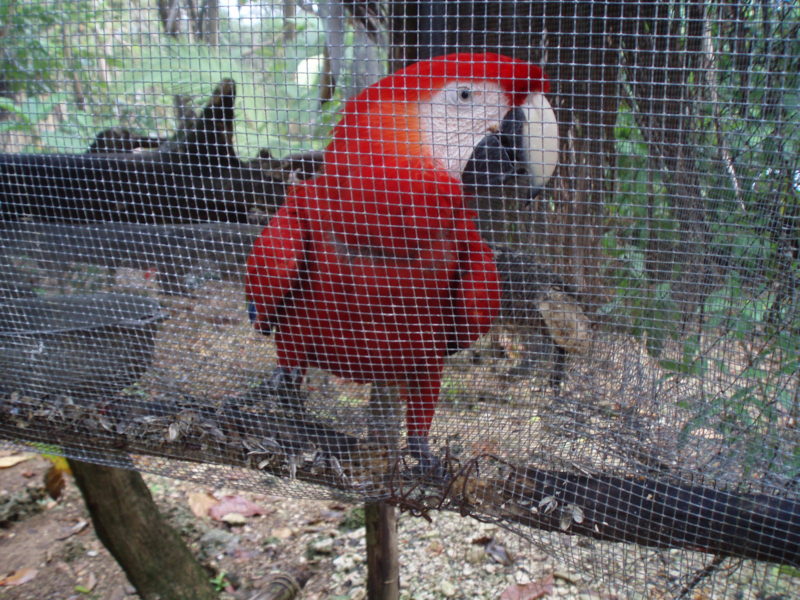
Where: This zoo, located in the 1A section of Chapultepec Park, is best reached from Auditorio Metro Station (Line 7).
Hours:
- 9:00 am – 4:30 pm, Tuesday through Sunday
- Closed each Monday, Christmas, and New Year’s Day.
Website: www.sedema.cdmx.gob.mx
This world-class zoo is famous for being the first place outside China to have pandas born while in captivity. The zoo still has three of these pandas on display along with every other type of creature you’d expect to see. This sight is staggering in scope and size so expect to spend all day walking around Chapultepec Zoo.
This is truly a world-class zoo and the experience is totally free! We visited during Semana Santa (Easter) and it really was a zoo. Visiting during Easter likely won’t qualify as one of the the best non-touristy things to do in Mexico City, but it’s still free! Instead, visit outside of Christmas and July and August as this is when many Mexicans go on holidays.
Museo del Estanquillo

Where: Corners of Avenida Francisco Madero and Isabel la Católica in Mexico City’s Centro Historico.
Hours:
- 10:00 am – 6:00 pm Wednesday through Monday
- Closed Tuesday
Website: www.museodelestanquillo.cdmx.gob.mx
Combine: This Centro Historico sight combines quite easily with the Palacio de la Escuela de Medicina and the Palacio Nacional, both below.
Pop in here if you’re long on time but short on pesos. This rather extensive collection of drawings, photography, toys and dioramas representative of Mexican culture belonged to journalist Carlos Monsiváis. In addition, this museum features quite a variety of temporary exhibits. Expect a fascinating cultural collection during your visit and, most importantly, leave behind the tourist sights for a while.
The rooftop terrace looks up and down pedestrianised Avenida Francisco Madero. Diagonally across looms Templo San Felipe Neri, also free and totally worth a visit. Imagine our surprise when this museum made our list of non-touristy things to do in Mexico City. It’s free, seldom visited and certainly worth having a good look around in.
Palacio de la Escuela de Medicina

Where: Corners of República de Brasil and Venezuela, four blocks directly behind the Zócalo. The rather obvious fully dissected female cadaver in the entrance to this museum indicates you’re here.
Hours: 9:00 am – 6:00 pm daily.
The former Palacío de la Inquisición now holds an oddly fascinating museum. The exhibits chronicle medical developments from pre-Columbian herbalists to modern surgical breakthroughs. Here you’ll find a replica nineteenth century chemists, ancient x-ray machines and cases displaying both crude and quite elaborate surgical instruments through the ages.
Fascinating life-like figures, sliced every way imaginable, portray the body’s foibles, maladies and vulnerabilities. Marvel at the deformed genitalia display which serves as a warning against various STDs. This ticks the box for macabre, non-touristy things to do in Mexico City quite nicely. Palacio de la Escuela de Medicina is expertly cure-ated and very fun to visit, too.
Palacio Nacional
Where: Located on the east side of Mexico City’s vast Zócalo.
Hours:
- 9:00 am – 5:00 pm Tuesday through Sunday
- Closed Monday
Note: Government issued ID is required for admission to Palacio Nacional.
This rather imposing building houses Mexico’s presidential offices. Above the palace’s central doorway hangs the historical Campana de Dolores, the bell sounded by Padre Hidalgo in 1810 heralding Mexico’s War of Independence. Each September 15th, the eve of Mexico’s Independence Day, the president rings this bell and delivers the shout of ¡Viva México!, known as el grito, from a balcony overlooking the Zócalo.
The inner courtyard walls are awash with murals by Diego Rivera, painted between 1929 and 1951. The dominant murals portray a host of who’s who in Mexican lore representing pre-conquest times, the brutality and wake of the conquest, pre-revolutionary Mexico and post-revolution ideals, for example. This hardly qualifies as a non-touristy thing to do in Mexico City but it is free.
Fuente de Tláloc & Museo del Carcamo de Dolores
Where: Southeast corner of Chapultepec Park in section 2A. From Constituyentes Metro Station (Line 7) head northwest 1 block to the corner of the park and follow signs to Fuente de Tlaloc.
Hours – Museo del Carcamo de Dolores:
- 10:00 am – 5:00 pm Tuesday through Sunday
- Closed Monday.
This fountain is Diego Rivera’s representation of the Aztec rain god Tláloc. This massive, tiled work occupies a pool directly in front of the Cárcamo de Dolores. This entire system was built to channel water flow from the Lerma River to municipal reservoirs in Mexico City.
A 20 peso admission fee grants you access to the Cárcamo Museum located behind the fountain. The interior walls are covered in murals known as El Agua, El Origen de la Vida, and portray Rivera’s vision of water and all of its life-giving properties.
The most symbolic mural is found above where water flowed to the fountain, portraying two large cupped hands scooping water. Considering the Diego Rivera connection Fuente de Tláloc is surprisingly off the beaten path in Mexico City.
Museo Mural Diego Rivera

Where: Located on the far west end of the Alameda, to the left of Palcio de Bellas Artes.
Hours:
- 10:00 am – 6:00 pm, Tuesday through Sunday
- Closed Monday
Website: www.museomuraldiegorivera.inba.gob.mx
This corner of the Alameda which once hosted burnt heretics during the Inquisition now celebrates one of Mexico’s most beloved artists – Diego Rivera. The big draw is the mural Sueño de una Tarde Dominical en la Alameda Central, or Dream of a Sunday Afternoon in the Alameda Central. This 15m long mural plays host to a plethora of famous and infamous Mexican figures throughout history strolling through the park.
The focal figure of this work is La Calavera Catrina, the elegant skeleton rather synonymous with Mexican culture. Immediately surrounding her are Rivera as a child, Frida Kahlo and La Catrina’s creator, José Guadalupe Posada.
Note: This museum charges a fee for both photography and video recording. Inquire at the admissions desk for details and current prices.
Estadio Olímpico Universitario

Where: West of Universidad Nacional Autónoma de Mexico campus. See below for directions.
Website: For football matches featuring Mexico City’s team, the Pumas, visit www.pumas.mx
Combine: Visit Estadio Olímpico Universitario with Universidad Nacional Autónoma de Mexico, below.
Above the main façade is a mosaic by Diego Rivera – The University, the Mexican Family, Peace and Youth Sports. His plan was to wrap the mosaic around entire outer circumference of the stadium but Rivera died in 1957 and this was never achieved. The stadium also hosted the 1968 Summer Olympics and it’s embellished entrance featuring a tribute to sport continues to welcome fans today.
Universidad Nacional Autónoma de Mexico (UNAM)

Where: Both UNAM and Estadio Olímpico Universitario (above) are reached on the Metro. From Copilco Station (Line 3) head south to the sprawling university campus. Alternatively, take a bus from San Ángel neighbourhood; buses heading south on Insurgentes Sur stop at the stadium.
Combine: Cross busy Avenida Insurgentes Sur to access Estadio Olímpico.
Take a stroll through this rather fascinating university campus and admire some fine mosaics. The university, founded in 1551, has resided in this current location since the 1950’s and was listed as a UNESCO World Heritage Site in 2007.
The Biblioteca Central (Central Library) greets visitors with an emblazened mosaic by Juan O’Gorman. Murals on Auditorio Alfonso Caso include La Conquista de la Energía by José Chávez Morado andThe Four Elements by Francisco Eppens Helguera on the Facultad de Medicina building.
Viveros de Coyoacán
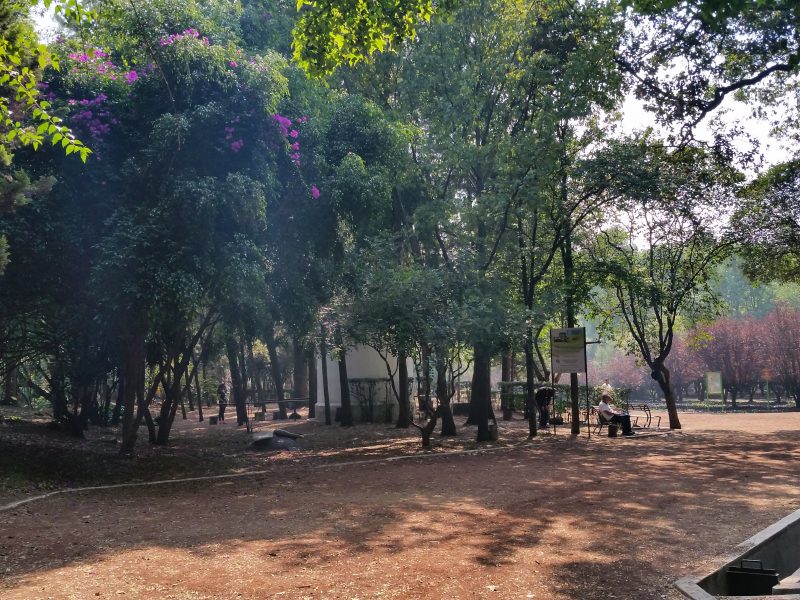
Where: Take the Metro to Viveros Station (Line 3) to get to this unique, leafy park approximately 5 blocks west of Casa Azul.
This surprisingly peaceful park is overlooked by many tourists. However, local dog walkers, power walkers, families and joggers all utilize a network of leafy paths throughout this space. Viveros de Coyoacán is the nursery for Mexico City’s parks and gardens department and workers keep busy watering and pruning much of the fauna on display. These are ultimately planted throughout Mexico City.
This park makes it quite easy to forget you’re in the middle of a giant city, so get lost here for a bit. Pathways crisscrossing Viveros de Coyoacán feature sculptures and other works of art sprinkled throughout. This is a great spot for picnic or to catch your breath before contemplating what to do next. So seek out some respite from the city and make your way to Viveros de Coyoacán.
Santa Muerte

Where: Avenida Alfarería in Mexico City’s Tepito neighbourhood. From Tepito Metro Station (Line B) head north through the neighbourhhood market to the shrine.
Combine: Include a visit to Plaza de las Culturas to this neighborhood holy shrine. See below for details.
Come here if you dare! This neighbourhood is certainly considered one of the most dangerous in Mexico City. We had no bother at all during our visit but were well aware this wasn’t a tourist area. Our barrio wanderings led us to an interesting street-side shrine occupied by a dainty deity equally adored and despised in Mexico.
The devout, refer to her as skinny lady, bony lady, godmother and lady of the shadows. In 2001 Doña Queta, built a public shrine to Santa Muerte in the Tepito neighbourhood. The first of each month sees devotees bringing all manner of personal tokens of gratitude and affection to their Señora de la Santa Muerte.

Santa Muerte is rather prevalent with gangs, cartels, traffickers, prisoners, prostitutes and other aspects of society’s underbelly. There is also a very human element to her devotees too, that have nothing to do with crime.
Often those living on the outer margins of society in impoverished conditions seek solace in their veneration of her. However, her popularity provides anything but solace for the Catholic Church who considers her following a cult.
Plaza de las Tres Culturas
Where: From Tlatelolco Metro Station (Line 3) turn right on Manuel Gonzalez. Continue straight for 2 blocks, then right on Eje. Central Lázaro Cárdenas. Plaza de las Tres Culturas is across this street.
Hours:
- Ruins: 8:00 am – 6:00 pm, daily.
- Centro Cultural Universitario Tlatelolco: 11:00 am – 6:00 pm Tuesday through Sunday. Closed Monday.
Website: www.tlatelolco.inah.gob.mx
This unassuming site north of the Zócalo belies the momentous events which transpired here. The reference to the namesake three cultures are indicative of the pre-Hispanic, Colonial and modern buildings occupying this site.
This site witnessed the Aztec’s last stand against Cortés and his troops. The fall of the Aztec empire and the conquest of the Spanish laid way to the rise of Colonialism. A plaque reads – “…This was neither victory nor defeat. It was the sad birth of the mestizo people that is Mexico today”.
In more recent memory this was the site of a 1968 student massacre carried out by government troops. Official numbers are questionable, however it’s thought that nearly 300 students died protesting government corruption and oppression.
Today visitors may walk amongst ruined pyramids from the great Aztec market city of Tlatelolco and visit the Templo de Santiago, built by the Spanish out of repurposed stones from the vanquished Aztec structures.
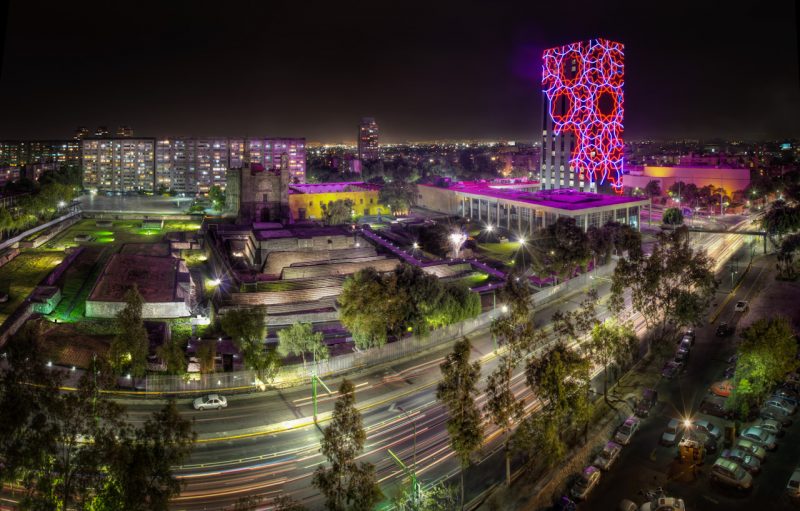
Overlooking these historic structures are modern buildings, most noteworthy being the Centro Cultural Universitario Tlatelolco. Here, a permanent multimedia exhibition chronicles events leading up to the 1968 student movement and the ensuing massacre.
This building is easily identifiable at night due to the spectacular light installation known as Xipe Tótec covering the exterior. This latest public art display has become one of the newest Mexico City landmarks, shining light on a site of sorrow and significance for many.
Finally…
I suggest you walk around and discover more things to do in Mexico City. Take my self-guided street art tour and see where you end up after that. The vast Centro Histórico section is full of enough evocative architecture, museums, restaurants, markets and plazas to keep you on your feet for days. Take note of the many cracked and listing old buildings, which brings me to my final suggestions…
Make your way to Plaza Loreto, located several blocks northwest of the Zócalo, noteworthy for 2 very unique churches:
Iglesia Neustra de Señora de Loreto
Where: Corners of San Ildefonso and Calle Loreto, Plaza Loreto.
This wildly wonky church will make you dizzy before you even set foot inside. Earthquakes and sinking substratum have left this church cracked and leaning over the centuries and nowhere is this more evident than within.
The church’s shaky past and spongy foundation have created both a raised and sunken floor – depending on where you stand, of course! Feel the full-on fun house effect and try not to lose your balance, especially as you look up to to the vaulted ceiling.
Parroquia Santa Teresa la Nueva
Where: Opposite Iglesia Nuestra de Señora de Loreto
This small parish church contains several holy relics and waxy-looking saintly figures in glass display cases. The real star here is the artificial cave featuring an Our Lady of Fátima apparition at the back of the church.
Plaza Loreto
Take a seat near the fountain on Plaza Loreto, across from the churches and take a well-deserved break. Then jump right back in and discover your own free, non-touristy things to do.
Pin Me Now!
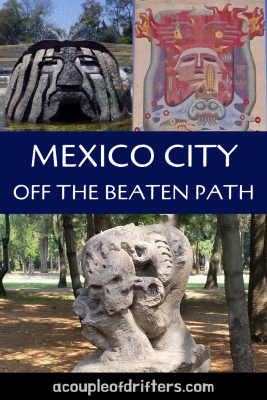




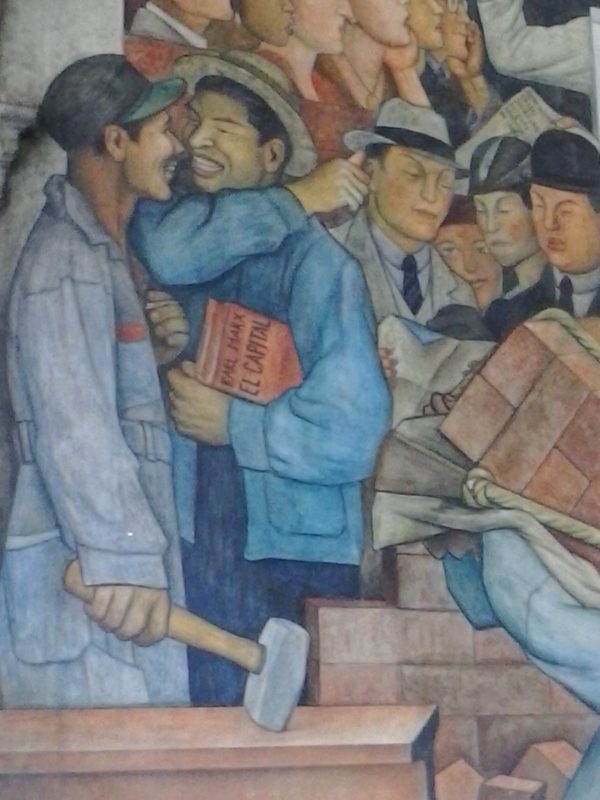


Wow, the art on that university building is so amazing! Mexico City looks like it has SO much to offer tourists. I love museums and if the weather is hot outside, you’ll usually find me in one 🙂 Thanks for listing a few options.
Carmen,
Mexico City has one of the highest concentrations of museums in the world. We bet you’d love it here.
Your Drifters,
Fiona and Jerry
There is so much to see and experience in the vibrant Mexico city. You have listed down some pretty offbeat and quirky experiences. And best of all is these are all free. We love Museums as they open windows to the culture and history of a place apart from enriching you with knowledge on so many aspects. Love the fact that the list covers some unique museums. The Museo De La Medicina seems especially interesting. Great list and very useful to the first time visitor to Mexico City.
Sandy and Vyjay,
Nothing beats free! Perhaps you two will plan a trip to Mexico City one day soon?
Your Drifters,
Fiona and Jerry
Such a great array of free activities. I love it! We’ve seen a lot of fountains in our travels but I’d love to see the Fuente de Tlaloc. It’s so unique!
Joanne,
SO much to do in Mexico City – this is indeed a world-class destination!
Your Drifters,
Fiona and Jerry
Wow, there are so many free sights in Mexico City. All are very vibrant and worth visiting. I loved the bazaar de la Roma the most.
Hello Yukiti,
Bazaar de la Roma is gem of a place, no doubt. There are a ton of free sights in Mexico City and we only just scratched the surface!
Your Drifters,
Fiona and Jerry
It’s nice that there are so many amazing free sites in Mexico City. I’ll probably skip the heavy metal area but would love to check out the Museo de la Medicina. The life-like wax exhibit sounds so different and interesting. I’ve never seen an exhibit like that and it sounds like a one-of-a-kind.
Candy,
If you like the sound of the Medical Museum, I have a hunch the heavy metal market may be just the thing for you!
Your Drifters,
Jerry and Fiona
Mexico city seems like such an interesting place, great to know there are so many free things to do. We love heavy metal so that festival would be ideal for us! I love the amount of public art too, that’s cool to see! We also love all the day of the dead/ Santa Muerta stuff too, maybe its because we’re metal heads!
Nic,
I love my metal music as well – and this market is a weekly thing! It’s great fun, no doubt. Day of the Dead is great anywhere in Mexico. Sounds like you both need to make the trip.
Your Drifters,
Jerry and Fiona
I need to get to Mexico City! I am the type of traveller who loves to wander and it sounds like a great city for exploring on foot. Might have to make my way to the National Palace and the Bazar de la Roma ! Great info. Will keep it for when I visit this city!
Alison,
Let us know when you visit!
Your Drifters,
Jerry and Fiona
I’ve been to Quintana Roo State and Valladolid area but never been to Mexico City, to be honest, been wondering about that city and want to know what’s the difference between the city. I love how you list the free things to do in Mexico City for us to explore and not empty our pockets! Thanks for sharing very helpful especially for first-time visitors.
April,
Free is good. Free in Mexico City is even BETTER!
Your Drifters,
Jerry and Fiona
Wow so many things to do in Mexico City! I just spent the weekend in Valladolid, and now I know where part of Mexico to visit thanks! Thanks for sharing these great sights in the city. Definitely adding this to my list 🙂
Yara,
Been to Mexico? You need to get to Mexico City. We spent 5 weeks here and never ran out of things to do.
Your Drifters,
Jerry and Fiona
Great tips, but my all time favourite is the advice to just walk about. It’s my favourite thing to do as an architecture lover and there are some real gems here. I really want to see that library on my next visit, I had not heard of it before.
Paula,
Just walking around the city will do – there is plenty of evocative architecture and wonderful street art throughout.
Your Drifters,
Jerry and Fiona